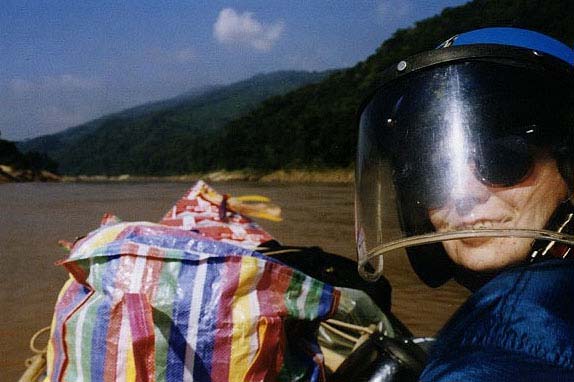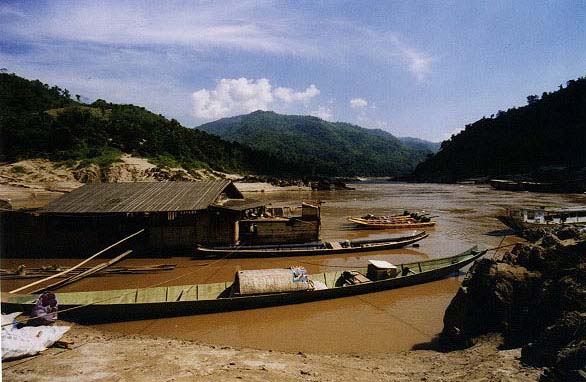
A Speedboat Along the Mekong
 |
| Riding upriver at 70 miles per hour |
 and headed for the riverbank. We sat on the steps of Wat Xieng Thong, hoping maybe Boua Geun would come by. He didn't, but a little boy smiled at me from the road. I waved, and he shyly waved back. The boatman from yesterday found us on the stairs, then led us down to his boat. We walked the plank that spanned from the sand to the deck of his longboat. This time a young man was at the bow. His son maybe? The teenager pushed the oar against the riverbank and set the long boat on its way.
and headed for the riverbank. We sat on the steps of Wat Xieng Thong, hoping maybe Boua Geun would come by. He didn't, but a little boy smiled at me from the road. I waved, and he shyly waved back. The boatman from yesterday found us on the stairs, then led us down to his boat. We walked the plank that spanned from the sand to the deck of his longboat. This time a young man was at the bow. His son maybe? The teenager pushed the oar against the riverbank and set the long boat on its way. The longboat pulled over at the speedboat dock a few kilometers upstream. Andy and the boatman went uphill to meet the speedboat driver while I stayed on the shore. Women stood on floating bamboo rafts and washed clothes. The boatman's assistant sat on the edge of the long boat and drew shapes in the sand with his toe. Andy called down to me and motioned that I should come up the hill. With my backpack still strapped on, I huffed and puffed my way up the unevenly placed stone steps to the top of the hill. As I was going up, I passed the boatman on his way down. We didn't really make eye contact though since I was too busy trying to find my footing on the jagged steps.
At the top of the hill, I found a little marketplace with leaf covered huts. Andy said we'd be leaving in about a half an hour, so get comfortable. I sat down on a wooden bench and looked out over the Mekong. Down below I could see the boatman shoving off. I asked Andy if he'd paid him yet. Andy shook his head no. We ran to the lip of the hillside and held up a handful of money. The boatman didn't respond. Andy had given him a 30% tip the day before, so maybe he thought we pre-paid. Or maybe he was getting a cut from the speed boat driver. Either way, we wanted to pay him for that morning's trip because we really liked him. Without stopping, the boatman and his assistant paddled downriver and out of sight.
A few minutes later, it was time to go. A couple of guys strapped our backpacks onto the front of the speedboat, handed us helmets and stuffed us into the seats. The boat looked pretty flat, rising only about two feet above the water. There was no roof, and since it was designed for speed, the skeleton of the boat was thin and sleek. The motor was in the back, and the "seats" were formed by plank dividers. We each sat in between two dividers. The space was just enough so that we could sit Indian-style somewhat comfortably. I think we each had about three and a half feet by two feet (which sounds bigger than it feels). Anyway, it wasn't that bad. I finally got my helmet to fit, slipped on my anorak, adjusted my legs and enjoyed the ride.
I have no idea how fast we were going. Andy guessed 70 kilometers per hour. Someday we'll have to do the math. Even with the helmet and its windscreen, the breeze zipped right through and ripped across my face. Multi-colored strings, tied to the front of the boat, braided themselves in the wind, rapidly unbraided, then whipped around and braided again. The ride was exhilarating. Butterflies passed by, then followed in our wake. When we cut through choppy waves, the boat slapped hard against the water. Along the riverbanks, stretches of jungle flew by.
We stopped at a police checkpoint, showed our passports and continued on. A couple hundred feet down the riverbank, we pulled over again for a young man who was thumbing a ride to the next village. He squeezed in next to Andy. Since he was riding behind me, I couldn't really see him, but I could smell him. Even in the open wind, I could smell the pot on this guy. Marijuana must have seeped into the fibers of his clothing. Andy later told me that he had an enormous, cigar-sized joint smoldering between his left foot toes. Eventually he figured out how to smoke it under his helmet. He tossed Andy a wide grin and offered him a toke. Andy politely declined.
The first few hours were fun, but this trip was seven hours long, and after another checkpoint, more villagers sqeezed in next to us. Suddenly my three and a half foot space became two feet. I had to hug my knees to my chest so we could all fit. After three hours, we stopped at another checkpoint, the village of Pakbeng. The driver directed us all off the boat. It was a much needed chance to stretch our legs. Pakbeng was the most bizarre police checkpoint I have ever seen. It was a floating bamboo hut, covered with dried palm leaves. A rope anchored this barge to a sand hill on the riverbank. A wooden plank ran from the hut to the land, and a rope, stretched across and above the plank, functioned as a handrail.



